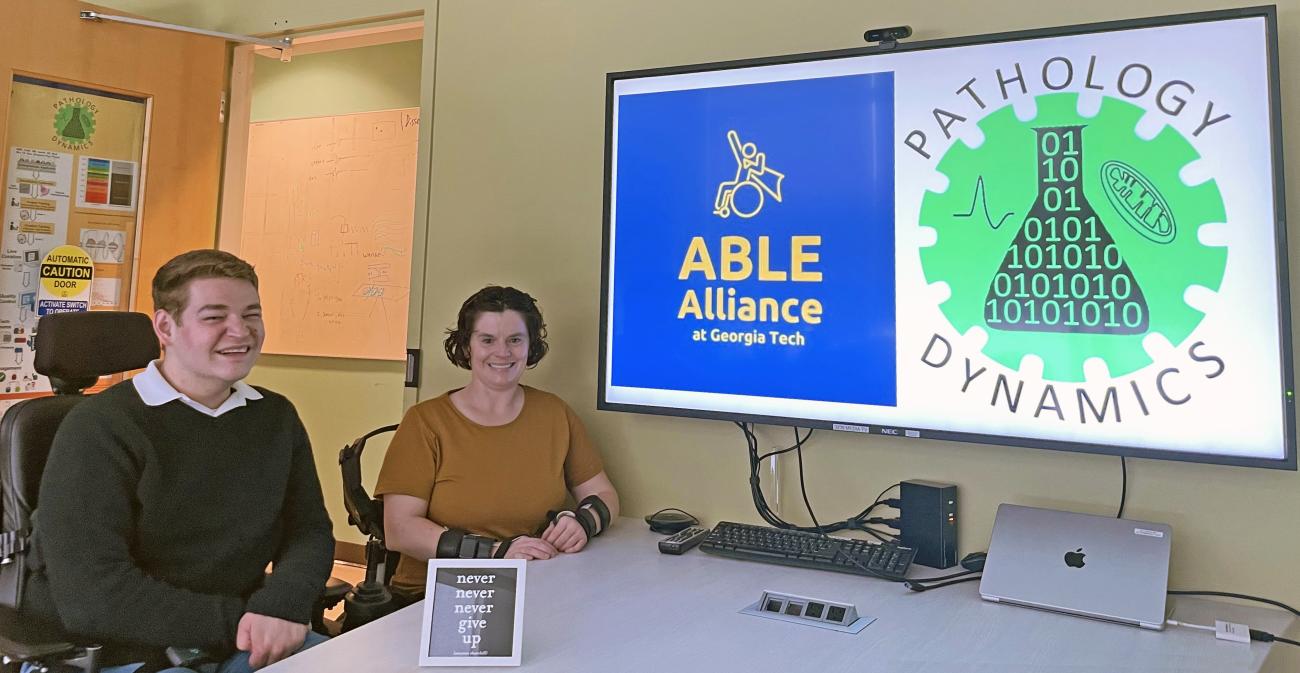By Jerry Grillo
Cassie Mitchell and Robert “Trey” Quinn have a few questions they’d like to ask you, and there really are no wrong answers.
They’re launching a new study focused on disability in the STEM fields of work — science, technology, engineering, and mathematics, which they hypothesize are a good fit for people with physical disabilities. Technology has made the work more accessible. Plus, the pay is good. However, there are challenges for working people with disabilities that even a great salary can’t overcome.
“We envision a scenario in which people with disabilities can get into the workforce and provide for their needs,” said Mitchell, associate professor in the Wallace H. Coulter Department of Biomedical Engineering.
Quinn, one of Mitchell’s former students, graduated in May with his master’s in computer science. He was well-known on campus for the sign attached to the back of his wheelchair, which said “THWG” — or “To Hell With Georgia” — a nod to the famous Georgia Tech-University of Georgia rivalry Quinn shares with his older sister, who attended UGA.
“The overall objective with this data-enabled study is to highlight the factors in academia and industry that have historically inhibited the successful inclusion of disabled people in STEM work,” said Quinn, who took the lead role in this study, which will gather data from both non-disabled and disabled people.
“We want to get a more complete picture of the current landscape, of the educational environment and the workplace,” said Mitchell, principal investigator of the Laboratory for Pathology Dynamics.
Increasing the Sample Size
The study is part of the Science Leadership award Mitchell’s lab received in October 2022. This program, supported by the Chan Zuckerberg Initiative and the National Academies of Sciences, Engineering, and Medicine, supports early-career biomedical researchers who have a record of promoting equity. The award includes a $1.15 million grant over five years.
Mitchell, an internationally recognized Paralympian, developed a neurological condition as a teen that resulted in quadriplegia. She’s always made it a point in her lab to include students from diverse backgrounds and disabilities.
“There is almost no data out there about the inclusion of disabled people in the workforce, only tiny sample sizes,” Mitchell said. “So we wanted to go after a larger sample size. Because if we are not reaching appropriate inclusion — and the few existing studies show that we’re not — then we want to know why.”
Quinn added, “Stable and high-paying careers in STEM fields seem like a viable option for people with disabilities to both achieve and maintain financial independence.”
Grappling With the Disability Tax
For a person with significant disability, even a good-paying job may not be enough to offset the “disability tax.” Quinn defines the tax as “the extra time and money that living with a disability takes.”
For example, some people need a monthly disability check to cover common living expenses. But often, a more valuable government benefit is a health plan that covers “the thousands of dollars per month in personal support and care services,” Quinn explained. “You often only qualify for this if you’re on government disability benefits and making less than a certain amount of money per month.”
Also, policies vary by state, so individuals can easily fall through the cracks due to the complexities of various programs. And private or employer-funded healthcare plans typically can’t compete with government plans, which cover these expensive personal support services.
For many people with disabilities, it comes down to a choice between working or government-supported services.
“There doesn’t seem to be a middle ground,” said Mitchell, who estimates approximately 60% of her income supports her medical and disability needs. “And that’s after insurance.”
The researchers hope their study provides momentum that will result in something close to full accessibility.
“This study will illuminate the challenges, even if it doesn’t solve them,” said Mitchell. “And while we’re focusing on STEM, this kind of study can be extrapolated to other fields as well. Whether you’re in science or not, I think people understand we’re asking important societal questions.”
Latest BME News
Jo honored for his impact on science and mentorship
The department rises to the top in biomedical engineering programs for undergraduate education.
Commercialization program in Coulter BME announces project teams who will receive support to get their research to market.
Courses in the Wallace H. Coulter Department of Biomedical Engineering are being reformatted to incorporate AI and machine learning so students are prepared for a data-driven biotech sector.
Influenced by her mother's journey in engineering, Sriya Surapaneni hopes to inspire other young women in the field.
Coulter BME Professor Earns Tenure, Eyes Future of Innovation in Health and Medicine
The grant will fund the development of cutting-edge technology that could detect colorectal cancer through a simple breath test
The surgical support device landed Coulter BME its 4th consecutive win for the College of Engineering competition.








